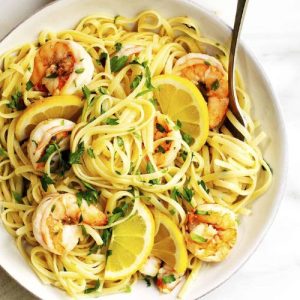
20-Minute Lemon Garlic Shrimp Pasta
A quick and flavorful pasta dish featuring juicy shrimp, fresh lemon, and a hint of garlic, all tossed with tender spaghetti. Ready in just 20 minutes, this recipe is perfect for busy weeknights while still tasting fresh and elegant.
Equipment
- 1 large pot (for boiling pasta)
- 1 large skillet (for cooking shrimp and sauce)
- 1 colander (for draining pasta)
- 1 citrus zester or fine grater
- 1 citrus juicer (or small bowl and fork)
- 1 Wooden spoon (for stirring)
- 1 measuring cup (for pasta water)
Ingredients
- 12 ounces spaghetti or other long pasta
- 3 tablespoons olive oil
- 2 tablespoons unsalted butter
- 5 cloves garlic minced
- ¼ teaspoon red pepper flakes or more to taste
- 1 pound shrimp peeled and deveined
- 1 large lemon juiced and zested
- ¼ cup fresh parsley chopped
- Salt to taste
- Black pepper to taste
- 2 ounces Parmesan cheese freshly grated (optional)
Instructions
- Prepare and Boil the Pasta: Fill a large pot with water, about three-quarters full, and bring it to a rolling boil over high heat. Once the water is bubbling vigorously, add a generous pinch of kosher salt—this step seasons the pasta from the inside out. Gently drop in the spaghetti (or your choice of long pasta) and stir once or twice to prevent sticking. Cook until the noodles are tender yet firm to the bite, also known as al dente, usually around 8–9 minutes depending on the brand. Before draining, carefully scoop out about 1 cup of the starchy pasta water using a heatproof measuring cup and set it aside—you’ll need this liquid gold later to create a silky sauce. Drain the pasta in a colander and let it rest briefly while you prepare the shrimp.
- Heat the Pan and Melt the Base: Place a large skillet on the stovetop over medium-high heat. Add the olive oil followed by the butter. As the butter melts and combines with the oil, you’ll notice it starting to sizzle and foam slightly. This combination of fats creates both rich flavor and high cooking stability, ensuring the shrimp cook beautifully without burning. Swirl the pan gently to coat the bottom evenly with the buttery oil mixture.
- Infuse the Oil with Garlic and Spice: Once the butter is fully melted and the pan is hot, add the minced garlic and crushed red pepper flakes. Stir continuously for about 30 seconds, just until the garlic releases its aroma and turns lightly golden. Be careful not to let the garlic brown too much—it should smell fragrant, not bitter. At this point, the base of your sauce is infused with layers of flavor that will coat the pasta later.
- Cook the Shrimp to Perfection: Add the peeled and deveined shrimp directly into the sizzling pan. Spread them out so they form a single layer for even cooking. Allow them to cook for about 2–3 minutes on the first side until they turn opaque and pink, then flip each shrimp using tongs or a spatula. Cook the other side for another 1–2 minutes, just until the shrimp curl slightly into a “C” shape and are firm but still juicy. Avoid overcooking, as shrimp can quickly turn rubbery. Once perfectly cooked, remove the skillet from the heat to prevent further cooking.
- Combine Pasta and Shrimp in Sauce: Return the skillet with shrimp to medium heat. Add the drained pasta directly into the skillet, using tongs to toss the noodles into the garlic butter shrimp mixture. Pour in about 1/4 cup of the reserved pasta water to loosen the sauce and help the flavors cling to the pasta strands. Continue tossing until every strand of spaghetti is glossy and coated with flavor. If the pasta looks a little dry, add more of the reserved pasta water, a splash at a time, until it reaches a silky texture.
- Brighten with Lemon and Herbs: Remove the skillet from the heat once more, then add the freshly squeezed lemon juice and lemon zest. Toss well so the citrus flavor permeates the pasta and shrimp, giving the dish its signature brightness. Sprinkle in the chopped parsley, mixing it throughout for a burst of color and freshness. At this point, taste and adjust the seasoning with a little extra salt and freshly ground black pepper if needed.
- Finish and Serve the Dish: Transfer the finished pasta into a large serving bowl or individual plates. For a richer finish, sprinkle freshly grated Parmesan cheese over the top—it will melt slightly into the hot pasta, adding a creamy, savory touch. Serve immediately while warm, with extra lemon wedges on the side if you’d like to intensify the citrus flavor. Pair with a crisp green salad or garlic bread for a complete, restaurant-quality meal made right at home.
Notes
- Any long pasta works beautifully—spaghetti, linguine, or fettuccine.
- Reserve pasta water; it’s the secret to a glossy, flavorful sauce.
- Shrimp cook fast; pull them off heat once they curl and turn pink.
- Parmesan is optional—add it for richness, or leave it off for a fresher, lighter flavor.
- Adjust red pepper flakes based on your spice preference.